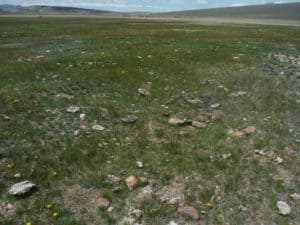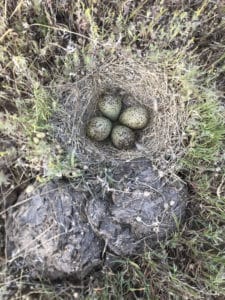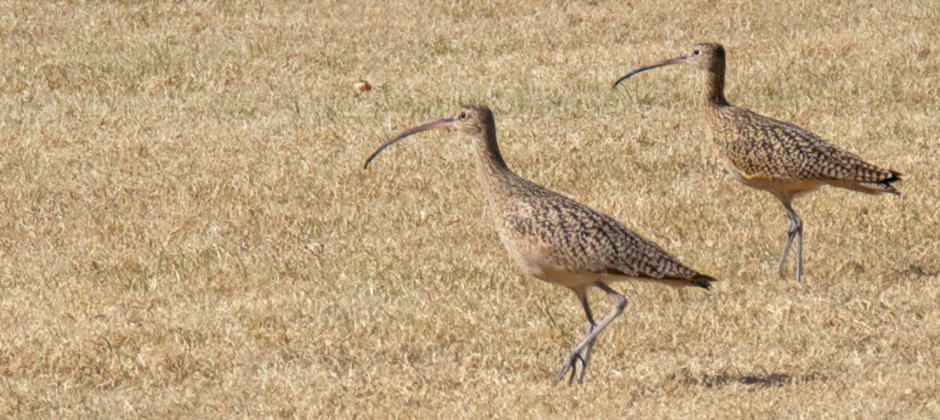Share this article
JWM: Cow pies provide curlews nesting spots
Curlews keen to feather their nests are best served by choosing areas with lots of other curlews — and lots of cow pies.
According to new research, long‐billed curlews (Numenius americanus) have higher nest success when they nest near cow pies or rocks.
“Curlews, when they are incubating, kind of look like cow pies, so it could be some sort of camouflage,” said TWS member Stephanie Coates, a research biologist at the Intermountain Bird Observatory at Boise State University and the lead author of a study published recently in The Journal of Wildlife Management.
Long-billed curlews are North America’s largest shorebird, spending their breeding months in much of the western U.S. and parts of Canada and their winters in Mexico and parts of California. As their name suggests, the birds sport long, thin, curved bills they use to poke through the sand for aquatic invertebrates in coastal areas, and to grab grasshoppers or other insects in grasslands. While they aren’t endangered, previous research conducted for the U.S. Bureau of Land Management had showed one population of curlews had dropped more than 90% between the late 1970s and 2014 in southwestern Idaho.
Some of the curlew declines in Idaho may be due to poaching. Between 2013 and 2018, the Intermountain Bird Observatory attached transmitters to 16 birds, seven of which were found shot — a very high percentage, Coates said. All these birds were tagged with transmitters in an area of southwestern Idaho were target shooting is frequently done.
“There is a really strong anthropogenic disturbance at this site in particular,” Coates said, adding that even though probably a small percentage of people are shooting the birds, the illegal poaching could have a huge impact on the population.
Another cause for the decline in curlews in Idaho might be due to an increase in predators attracted by Piute ground squirrels (Urocitellus mollis) shot legally in the area. Coates said that badgers and coyotes might be attracted to the area in larger numbers to feast on dead ground squirrel carrion left from target-shooting. These predators may come across curlew eggs and nests incidentally while scrounging around for ground squirrel corpses.

Curlew populations in at least one study area are declining rapidly, according to previous research. ©Benjamin Wright
“Nesting success is pretty low here compared to other sites we have studied,” she said.
Coates and her co-authors wanted to see what types of factors were associated with nesting success for the birds given the problems they face. They surveyed 128 nests at five sites between mountain areas in Idaho and Wyoming, though it’s unclear whether the birds are declining in that state as well.
They found that nest success varied greatly depending on the location, ranging from 12% to 40% during the 2015 and 2016 breeding seasons when the research was conducted.
Higher nest success occurred when a greater percentage of the area near the nests was covered in conspicuous objects like rocks or cow pies. While the researchers aren’t completely sure why this occurred, the objects could provide the birds cover from aerial predators, since a curlew sitting on a nest is similar in color and shape to dried cow manure.
Coates said that the birds may also use these cow pies and rocks as a type of launch pad to get out of their nest quickly to protect from ground-based predators like American badgers (Taxidea taxus) or coyotes (Canis latrans). Curlews have a particular decoy strategy to draw attention away from their eggs called a broken-wing display in which they feign injury through erratic movements.
“They do a distraction where they kind of whip off the nest and kind of hunch their wings,” Coates said. “Maybe that cow pie is something that makes it easy to get off the nest quickly.”

The curlews may nest close to cow pies to hide from predators, as they look similar from above. ©Stephanie Coates
The birds also had higher nesting success when they were nesting in an area with higher population density, Coates said, likely because the species also employs communal defense, mobbing potential predators and making alarm calls. If there’s a higher density of curlews around, there are more individuals to give an alarm call or to chase off a predator, she said.
Larger numbers of American crows (Corvus brachyrhynchos) and black‐billed magpies (Pica hudsonia) around the nesting site was also correlated with higher nesting success. While the researchers aren’t sure why, especially since these birds will consume curlew eggs, they think the corvids may help keep ground-based predators and ravens away.
“Anti‐predator mobbing by crows or corvids in general may have acted to moderate other avian and mammalian predators in curlew breeding areas,” the researchers wrote.
This article features research that was published in a TWS peer-reviewed journal. Individual online access to all TWS journal articles is a benefit of membership. Join TWS now to read the latest in wildlife research.
Header Image: Long-billed curlews prefer to make their nests close to cow pies. ©Gerry








